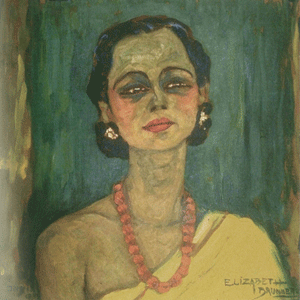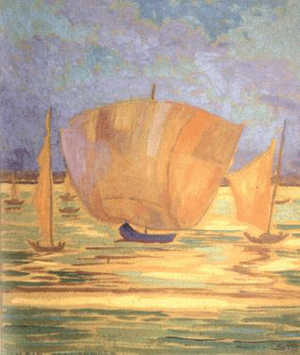
The works of Elizabeth Sass Brunner and Elizabeth Brunner show their life-long quest for spirituality and knowledge.
An unusual journey it may sound — especially because of the time it was undertaken in — but it did happen that a Hungarian mother-daughter duo of Elizabeth Sass Brunner (ESB) and Elizabeth Brunner (EB) way back in 1930 set sail for India.
The journey leading them to the path of spirituality and knowledge was spurred by a dream in which Elizabeth Brunner sees Rabindranath Tagore. India became their home where the two attained newer heights as artists.
The artists recorded their myriad experiences, learnings, discoveries, emotions and encounters on their canvases which were to be later hailed as masterpieces.
A few of these paintings by these prolific artists currently on display at Mati Ghar in the exhibition called “The Call of India” reflect the process they went through both as an artist and a person.
Spiritual journey
Imre Lazar, Director, Cultural Counsellor, Hungarian Information and Cultural Centre has selected these works out of the huge collection of the Brunners possessed by the Indira Gandhi National Centre for Arts (IGNCA). Lazar, curator of the show, has covered different periods and styles of the Brunners to weave an assortment which represents the most beautiful characteristics of their art.
“Their roots can be traced in the Hungarian art and even though they spent two years in Santiniketan, their way of expression which was expressionism, impressionism, pointillism was all very European.
But these are just the forms. What is important is that they discovered India through art and raised awareness amongst Indians to discover their own heritage.
What I wanted to show was not their physical journey but their spiritual journey. They came looking for something which they couldn’t find anywhere else,” describes Lazar.
While the mother’s oeuvre was marked by landscapes in the initial years and mysticism in the later period, the daughter executed portraits of people, temples and scenes of daily lives. From senior Brunner’s time in Hungary (1922-1929), Lazar has included the landscapes and moves on to include the works created in Italy, Tripoli and Egypt before they landed in India.
Before reaching Santiniketan, they visited Darjeeling where Elizabeth Sass Brunner was mesmerised by its mountains. Her oil on cardboard titled “Little train across the Darjeeling mountains” resulted from that fascination. However, her first painting in India was made in Santiniketan after the artist witnessed Holi celebrations in the idyllic university.
Like mother, the daughter Elizabeth Brunner too created her first canvas in Santiniketan, which was a portrait of Rabindranath Tagore. The young Brunner became an art student of the legendary Nandlal Bose.
Explaining the presence of a number of small-size works, Lazar says, “I discovered during the course that they had done plenty of small paintings on cardboard which can be treated like a diary. Also to show how a work progressed, I consciously included different versions of the same work like Elizabeth Sass Brunner’s ‘Trimurti’ or her ‘Rajasthani women at ancient well’ Rajasthan (1932). 
There were times when they would just do a small sketch and leave it at that. Months or years later, they would create the same work on a bigger scale. The work of ‘Rajasthani women’ is a simple work but one realises how from her one minute observation of a mundane scene, she developed a motif, for these women became symbolic of Indian women in her works afterwards,” says Lazar.
It’s interesting to note that even though the artists lived in the same surroundings, had similar experiences and inspirations but the language, they chose was completely different from each other. “Elizabeth Brunner started out as a sculptor and that approach is clearly evident in her works. The contrast of shaded part with the bright portions in her paintings of the Sravanabelagola in Karnataka or the figurines from the Sun Temple in Modera, Gujarat render immense plasticity to her work,” says Lazar.
Covering holy shrines and important pilgrimage centres across India, the duo imbibed the symbolism of Indian art. “In ‘Shiva, the Lord of Himalayas’, you don’t find the usual Indian iconography, Elizabeth created her own language.
‘Rainbow Desire’, ‘Trimurti’, Himalayan landscapes and Buddhist paintings are very significant works of Elizabeth Sass Brunner whereas portraits of personalities like Mahatma Gandhi (done in Bangalore), Sarojini Naidu, everyday lives of the commoners, tribals and ceremonies in the royal palaces are notable creations by Elizabeth Brunner.
Be it the portrait of Field Marshal Sam Manekshaw, Indira Gandhi, Jawaharlal Nehru or be it a toda tribal, a woman doing batik, she always managed to bring out the character of the person,” explains Lazar.
On view are also the photographs of Elizabeth Brunner in action executing the portraits public figures, religious leaders, dancers, actors — Indira Gandhi in a picture is seen modelling for the young Brunner — shows the access the artists had to the elite circles.
(The show is on at Mati Ghar, IGNCA till May 31)
Author : Shailaja Tripathi
Source : http://beta.thehindu.com




